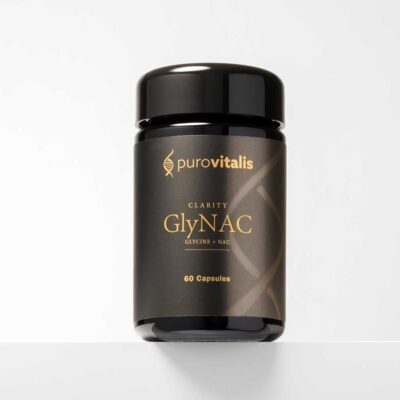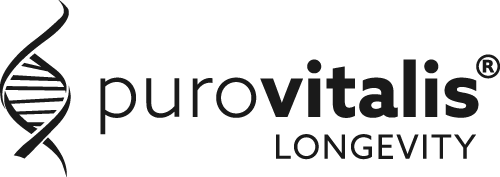
In recent years, two simple compounds — glycine and N-acetylcysteine (NAC) — have attracted growing attention for their potential roles in cancer biology. They’re known for supporting antioxidant systems in the body and maintaining cellular balance. But in cancer research, their effects are far from straightforward. Could they help protect healthy cells — or might they also shield cancer cells? Let’s explore what science knows so far.
table of contents
How glycine and NAC work in the body
Both glycine and NAC are deeply involved in cellular detoxification and antioxidant defense, mainly through their role in producing glutathione, one of the body’s most powerful antioxidants [1,2]
Glycine – The simplest amino acid with big responsibilities
Glycine is a small amino acid found naturally in the body. It contributes to protein formation, supports neurotransmission, and plays a role in detoxifying harmful compounds through bile acid conjugation [3–5].
It’s also a building block for glutathione, the antioxidant that helps protect cells from oxidative stress — the imbalance between harmful free radicals and antioxidants [2].
Definition of Glutathione
Glutathione is a molecule made from three amino acids — glycine, cysteine, and glutamate. It helps neutralize free radicals, supports the liver, and maintains cellular health.
NAC – The glutathione booster
N-acetylcysteine (NAC) is derived from the amino acid cysteine and is commonly used to support respiratory and liver health. Its key benefit is its ability to boost glutathione levels in the body [6–10].
NAC also reduces inflammation by influencing the NF-κB pathway, a major regulator of chronic inflammation [8]. Because of these effects, it’s often studied for its potential role in preventing or influencing cancer development.
Summary
Both glycine and NAC help produce glutathione, which protects cells from oxidative damage. That same protective ability is what has made researchers wonder if these molecules could influence cancer progression — for better or worse.
NAC and cancer risk
One of the earliest observations came from a large population study in Taiwan. Long-term NAC use among people with chronic lung disease was linked to a lower risk of developing several cancers, including liver, colorectal, and breast cancer [11].
Scientists suggest this could be because NAC reduces DNA damage and chronic inflammation, two major drivers of cancer formation [12,13]. By maintaining redox balance — the balance between oxidation and reduction reactions in cells — NAC might help prevent mutations that trigger cancer growth.
At the same time, animal and cell studies show a more complicated picture. In some cancer types, such as melanoma and lung cancer, NAC appeared to reduce oxidative stress so effectively that it unintentionally helped cancer cells survive and even spread [14,15].
Summary
NAC may help lower cancer risk in some people by reducing oxidative stress and DNA damage, but in some cancers, that same antioxidant effect might allow tumors to grow or spread more easily.
Antioxidant cancer therapy: A double-edged sword
The idea of antioxidants and cancer has always been complex. Oxidative stress can cause DNA mutations and promote cancer — yet it’s also used by chemotherapy and radiation to destroy cancer cells.
When NAC or glycine boosts glutathione, they may protect healthy cells from treatment-related damage, but they might also protect cancer cells from the oxidative stress these therapies rely on [14–17].
Still, researchers are exploring how antioxidants could be used strategically, not broadly. For example, NAC might be helpful after chemotherapy to help patients recover, rather than during treatment, when its protective effect could reduce therapy effectiveness.
Did you know?
Oxidative stress occurs when free radicals (unstable molecules) outnumber antioxidants in the body. It can damage DNA, proteins, and cell membranes — processes often involved in cancer development.
NAC and chemotherapy
There’s increasing interest in whether NAC could be used as an adjunct to cancer therapy — not to fight tumors directly, but to reduce treatment side effects.
Some studies have shown NAC can lessen chemotherapy-induced toxicity, such as nerve damage and liver stress, by replenishing glutathione levels and protecting normal tissues [18].
However, because some chemotherapies rely on oxidative stress to destroy cancer cells, doctors often caution against taking NAC during active treatment unless under strict medical supervision.
Summary
NAC may help protect healthy cells during cancer therapy, but it might also reduce the effectiveness of some treatments. Always consult a medical professional before combining supplements with chemotherapy.
NAC vs. GlyNAC
If NAC supports glutathione through cysteine and glycine boosts it directly, combining them could be powerful — and that’s the idea behind GlyNAC.
Clinical studies have shown GlyNAC can restore glutathione levels, improve mitochondrial function, and reduce oxidative stress in aging adults and people with metabolic disorders [19,20].
In theory, this combination could protect healthy tissues during cancer treatment, but there’s currently no clinical data confirming its safety or efficacy in cancer patients.
The right dosage in everything
Both glycine and NAC are considered safe for general use when taken at moderate doses. Glycine may cause mild stomach discomfort in high amounts [21,22], while NAC can lead to gastrointestinal issues or, rarely, allergic reactions [23,24].
The key challenge is context: a dose that’s protective in one situation could be harmful in another. In cancer, where oxidative balance is delicate, taking antioxidants without medical guidance could alter treatment effects.
Science summary: NAC and glycine
Glycine and NAC are essential for cellular protection and detoxification. Their potential in cancer prevention and treatment is promising — but also complicated. Research shows they can both shield normal cells and protect cancer cells, depending on how and when they’re used.
At this stage, neither is recommended as a standalone cancer therapy. Instead, they’re being studied as supportive nutrients that might improve health, reduce side effects, or help recovery under professional supervision.
Science continues to explore their dual nature — and future clinical trials will tell whether they become part of integrative oncology or remain supportive tools for overall wellness.
References
- Wu G. Amino acids: metabolism, functions, and nutrition. Amino Acids. 2009;37(1):1–17.
- Lu SC. Regulation of glutathione synthesis. Mol Aspects Med. 2009;30(1–2):42–59.
- Ducker GS, Rabinowitz JD. One-carbon metabolism in health and disease. Cell Metab. 2017;25(1):27–42.
- Legendre P. The glycinergic inhibitory synapse. Cell Mol Life Sci. 2001;58(5–6):760–93.
- Bellentani S, et al. The role of glycine in bile acid conjugation. Clin Sci (Lond). 1987;73(6):651–6.
- Samuni Y, et al. The chemistry and biological activities of N-acetylcysteine. Biochim Biophys Acta. 2013;1830(8):4117–29.
- Zafarullah M, et al. Molecular mechanisms of N-acetylcysteine actions. Cell Mol Life Sci. 2003;60(1):6–20.
- Rushworth GF, Megson IL. Existing and potential therapeutic uses for N-acetylcysteine. Pharmacol Ther. 2014;141(2):150–9.
- Dekhuijzen PN. Antioxidant properties of N-acetylcysteine. Eur Respir J. 2004;23(4):629–36.
- Atkuri KR, et al. N-Acetylcysteine—a safe antidote for cysteine/glutathione deficiency. Curr Opin Pharmacol. 2007;7(4):355–9.
- Lai SW, et al. Use of N-acetylcysteine and cancer risk. Cancer Epidemiol. 2013;37(5):523–6.
- De Flora S, et al. Mechanisms of N-acetylcysteine in the prevention of DNA damage and cancer. Carcinogenesis. 2001;22(7):999–1013.
- Sadowska AM, et al. Antioxidant and anti-inflammatory efficacy of NAC. Pulm Pharmacol Ther. 2007;20(1):9–22.
- Le Gal K, et al. Antioxidants can increase melanoma metastasis in mice. Sci Transl Med. 2015;7(308):308re8.
- Sayin VI, et al. Antioxidants accelerate lung cancer progression in mice. Sci Transl Med. 2014;6(221):221ra15.
- Harris IS, DeNicola GM. The complex interplay between antioxidants and ROS in cancer. Trends Cell Biol. 2020;30(6):440–51.
- Wang Y, et al. Superoxide dismutases: dual roles in ROS damage and signaling. J Cell Biol. 2018;217(6):1915–28.
- National Cancer Institute. N-acetylcysteine (PDQ®) – Health Professional Version. 2023.
- Kumar P, et al. GlyNAC supplementation improves glutathione deficiency, oxidative stress, mitochondrial dysfunction… Diabetes Care. 2021;44(12):2904–12.
- Sekhar RV, et al. Deficient synthesis of glutathione underlies oxidative stress in aging and can be corrected by cysteine and glycine. Am J Clin Nutr. 2011;94(3):847–53.
- Nakashima T, et al. Safety of glycine as an ingredient in foods. Food Chem Toxicol. 2005;43(2):187–95.
- EFSA. Scientific Opinion on the safety of glycine as a food additive. EFSA J. 2012;10(5):2705.
- Millea PJ. N-acetylcysteine: multiple clinical applications. Am Fam Physician. 2009;80(3):265–9.
- Kelly GS. Clinical applications of N-acetylcysteine. Altern Med Rev. 1998;3(2):114–27.

GlyNAC – Powerful Cellular Synergy Support glutathione production Fuel cellular energy
Experience the proven synergy of Glycine and N-Acetyl-Cysteïne. Together, they work more effectively than alone to restore glutathione levels, enhance mitochondrial function, and reduce oxidative stress.

Track 50+ health metrics with AI-powered accuracy. Start your free trial today and take control of your wellness journey!










